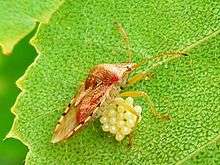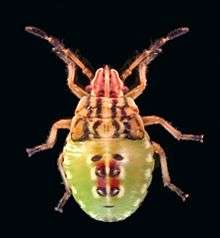Parent bug
| Parent bug | |
|---|---|
 | |
| Elasmucha grisea with eggs | |
| Scientific classification | |
| Kingdom: | Animalia |
| Phylum: | Arthropoda |
| Class: | Insecta |
| Order: | Hemiptera |
| Suborder: | Heteroptera |
| Superfamily: | Pentatomoidea |
| Family: | Acanthosomatidae |
| Genus: | Elasmucha |
| Species: | E. grisea |
| Binomial name | |
| Elasmucha grisea (Linnaeus, 1758) | |

Description
Parent bugs belong to the family Acanthosomatidae (Hemiptera) - so-called shield bugs or stink bugs.[1] and include the genus Elasmucha. Parent bugs possess methatoracic and abdominal glands, which discharge a foul smelling secretion.[2][3] This secretion is used to deter potential enemies and is sometimes released when the bug is disturbed.
Life cycle
Like most shield bugs, parent bugs suck plant sap and require symbiotic bacteria for their digestion.[4] They obtain symbionts at an early age: the mother covers her eggs with bacteria so that the larvae ingest them as they feed on the egg case.[4] Both adults and larvae readily feed on developing seeds, and breeding individuals can be observed on host plants with many young catkins.[5] However, they seem to avoid trees with a high predation risk.
Parental care
The common name comes from the relatively rare insect behaviour of prolonged caring for eggs and juveniles, exhibited by females of this species. Predators, such as bugs, beetles, earwigs and ants, can eliminate all the offspring of the parent bug if there is no maternal care. The repertoire of female defensive behaviours includes wing fanning, body jerking, tilting towards the enemy and, finally, releasing of 'nasty’ odours from the scent glands,[5][6][7]
After oviposition, the parent bug female stands over the egg batch and shields it throughout egg development. Predation appears to limit the clutch size in E. grisea. Experiments have shown that large females lay larger egg clutches than small females. However, when the clutch size was manipulated, small females protecting large clutches lost significantly more eggs than large females guarding small clutches or females in the control groups (guarding clutches of optimal size).[8]
After hatching, larvae of the parent bug remain in a tight aggregation, feeding on their empty egg shells.[3] When any larva tries to abandon the aggregation, the female tilts her body, stretches her antennae to reach the larva and pushes the larva back to the aggregation.[2] During the second and third instar they move, for food, towards catkins then back to the leaf with the female in close attendance.[3] The female keeps a lookout for the larvae constantly and manages them with touches of her antennae. Finally, larvae form smaller groups and disperse at the end of the third instar, at which point the female leaves them.
It has been noted that, in E. grisea, moultings during the early instar stages can be asynchronous.[2] While some larvae are still at the first instar stage, others have already moulted to the stage of second instar larvae and abandon the brood leaf for food. Under such circumstances, the female is no longer able to provide effective protection for all her larvae. The offspring of different females make contact with each other and form mixed groups. There is no kin-recognition in this species. Both single and joint guarding females provide parental care for their own larvae or other females’ offspring. Larvae are likely to benefit from 'kindergartens', when their mothers disappear or die.[2] Moreover, joint-guarding females defend the egg clutches much more successfully than single females.[9]
The tachinid fly, Subclytia rotundivertis, is a specialist endoparasite of the parent bug females.[10] The parasite inserts a single egg through the upper prothorax of an E. grisea female and, after hatching, the larva feeds on its host. At the beginning the parasite feeds only on the non-vital parts of the bug, but finally it kills it and pupates outside the host. Interestingly, the larva ‘permits’ the parent bug to continue caring for the juveniles until their third stage. In experiments, the wing-fanning (regarded as the most effective defensive behaviour of the parent bug) did not differ significantly between parasited and non-parasited females until the nymphs were at the second instar stage. However, with older nymphs, females were much less effective in their defensive behaviour and often died before the end of maternal care. Considering that the older nymphs are more mobile and may escape from predators, some offspring of the parasited females of the parent bug probably survive and may also be potential hosts for the new generation of the parasite.[10]
See also
References
- ↑ Gollner-Scheiding U (2006) Family Acanthosomatidae. Catalogue of the Heteroptera of the Palaearctic Region 5:166-181
- 1 2 3 4 Roth S, Adaschkiewitz, Fischer C (2006) Notes on the bionomics of Elasmucha grisea (LINNAEUS 1758) (Heteroptera, Acanthosomatidae) with special regard to joint brood guarding. zugleich Kataloge der OÖ, Landesmuseen Neue Serie 50:1153–1167
- 1 2 3 Hanelova J, Vilimova J (2013) Behaviour of the central European Acanthosomatidae (Hemiptera: Heteroptera: Pentatomoidea) during oviposition and parental care Acta Musei Moraviae, Scientiae biologicae 98:433-457
- 1 2 Fischer C (2006) The biological context and evolution of Pendergrast’s organs of Acanthosomatidae (Heteroptera, Pentatomoidea) 50:1041-1054
- 1 2 Mappes J, Kaitala A (1995) Host-plant selection and predation risk for offspring of the parent bug. Ecology 76:2668-2670
- ↑ Jordan KHC (1958) Die Biologie von Elasmucha grisea L. (Heteroptera: Acanthosomatidae). Beitr Entomol 8:385-397
- ↑ Melber A, Hölsher L, Schmidt GH (1980) Further studies on the social behaviour and the ecological significance in Elasmucha grisea L. (Hem.-Het.: Acanthostomatidae) Zool Anz Jena 205:27-38
- ↑ Mappes J, Kaitala A, (1994) Experiments with Elasmucha grisea L. (Heteroptera: Acanthosomatidae). Does a female parent bug lay as many eggs as she can defend? Behav Ecol 5:314-317
- ↑ Mappes J, Kaitala A, Alato RV (1995) Joint brood guarding in parent bugs – an experiment on defence against predation. Behav Ecol Sociobiol 36: 343-347
- 1 2 Mappes J (1994) Parasites and female ability to defend offspring in the parent bug Elsamucha grisea L. Ethology 97:76-80
External links
- "Species account: Parent bug". British Bugs.
- "Elasmucha grisea L.". Nature spot.
- "Observation of Elasmucha grisea L.".
- "Experiments with Elasmucha grisea L.". by Johanna Mappes and Arja Kaitala.
- "Distribution and Taxonomy".
- "Ovary structure in a presocial insect". by A.Ogorzałek , A.Trochimczuk.